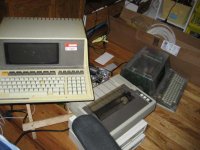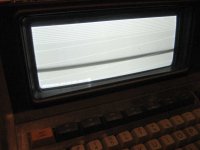infiniteneslives
New Member
- Joined
- Apr 21, 2012
- Messages
- 2


Well these goodies were have been sitting in the IEEE store that I've been volunteering at for the past couple years. Since I'm about to graduate I figured I'd look into obtaining them and picked em up for what I thought was a good price.
Initially I had planned to just re-sell them seeing some for high dollar listed on ebay. But I booted em up and I think I'm starting to fall in love...
Few questions for you guys:
* What's up with the one in the clear case? I haven't been able to find any info about it or pictures of a similar one on the net. I assume it's a HP-87 since it looks identical to the other that's clearly labeled. I did some quick researching on the clear case. Apparently HP made calculator prototypes in clear cases before the day of 3D cad and to make sure bubbles weren't injected and such. Am I right in assuming this is the case with this item also? Maybe it makes sense Oregon State ended up with it since the HP plant is here in town.
* Does the disk drive use 'standard' 3.5" floppies??? I'm guessing not, but they look like about the right sized slot.
* I posted a pic, as you can see the display on the clear cased one is a bit messed up. I initially got nothing when I turned it on and tried to reset it a few times. I lifted it and the screen started to flicker. A few more bits of mechanical agitation and I was able to get the screen to display well enough to see. After shooting the pic I lowered the brightness till it looked proper and tried to run a test calculation and it went blank again. It's kinda hard to get it to display anything when you want it to, it just keeps cutting out.
Any ideas of what might be the issue aside from video of some sort? Any suggestions of where I can look on the net or inside the PC to attempt to further diagnose or fix the problem? If this thing is actually a prototype maybe I'm best not to play around with it. Perhaps a future buyer would rather it be untouched... Thoughts?
In case my wife holds me to reselling these or at least one of them, what are they really worth including the printer/disc drives either working or not? I see some similar broke/working on ebay for $300-400 but not sure if anyone would actually pay that kind of money. If the clear cased one is indeed a gold mine that I happened upon I might have to wait around for the right buyer...
Thanks!
